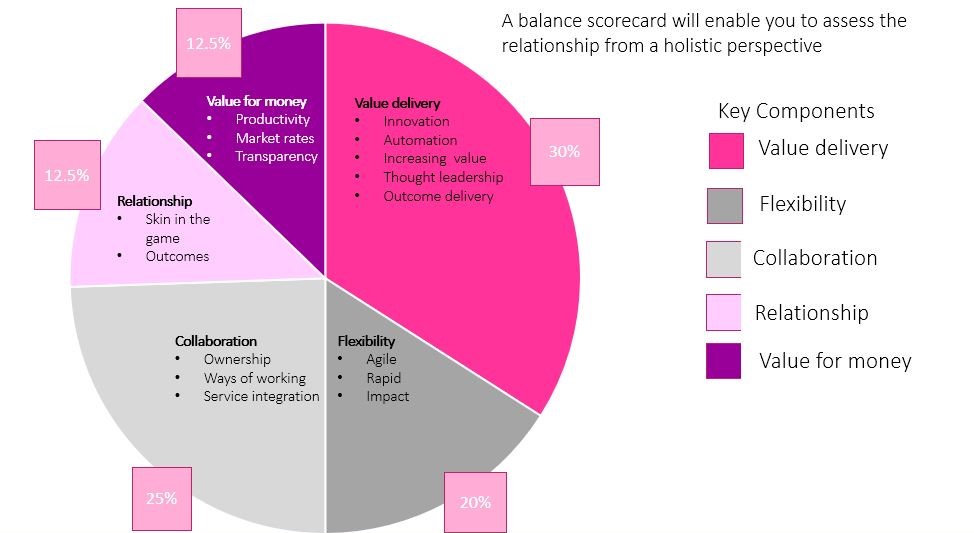The Future of Supplier Relationship Management in a Digital and Automated World
The future of IT delivery in an increasingly digital and automated world will become dependent on highly efficient and flexible sourcing. The model will need to flex over time and adapt to the emerging disruptors in the IT and business environments. This will mean that your Supplier Relationship model will have to adapt to accommodate these changes.
An effective Supplier Relationship model should enable you to:
- Build and maintain effective relationships
- Drive cost-effective service performance
- Realise expected benefits
- Extract the full potential value inherent in the relationship
- Minimise risks and over dependency
- Achieve and demonstrate good governance
At Quantum Plus we have devised a best in class framework for Supplier Relationship Management. We have outlined below the areas that you need to start considering for each component so that you can fully embrace a flexible and effective sourcing model.
Service Management – End to End Service
You will need to start thinking about increased collaboration, delivering seamless end to end service. Supplier collaboration models should be encouraged with Suppliers being encouraged to work together to enable a streamlined end to end service. There will be an increased need for SIAM due to the multi-sourcing nature of cloud/digital, and SLAs should be linked to desired outcomes not just performance. The ability to change / flex SLAs throughout the contract term is a key component to drive flexibility.
Performance Management
This area focusses on the end to end performance of the Supplier – not just the service delivery. Going forward, areas for consideration are:
- Qualified and measurable KPIs
- Delivered value - what is the value the Supplier is delivering
- Performance KPIs linked to behaviours as well as performance
- Net Promotor Score
A balance scorecard will enable you to assess the relationship from a holistic perspective.
Value Assessment
Assessing the value of your relationships through levels of;
- Productivity
- Automation
- Increase in speed to market,
will be key to getting the best value from your relationships. Areas such as those listed below will need to be embedded into your contracts and commercial terms.
- Productivity improvement - e.g. moving up the CMM levels to increase function points delivered and maintained per FTE and to improve software quality
- SSC rationalisation - e.g. moving to single regional and then global delivery centres, from dedicated to multi-client shared service centres
- Technology-enabled service transformation - introduction of new technology and tools, use of innovative solutions like RPA (Robotic Process Automation)
- Improved and accelerated delivery - higher service levels, faster project delivery, adoption of ‘Agile’
- Identification of high-RoI business projects - true IT innovation
Relationship Management
Your Suppliers will need to demonstrate a strong relationship model & their willingness to embrace service integration. Elements such as;
- Skin in the game – what the Supplier will put at risk
- Agile and flexible – contractual terms that enable change without penalty
- Demonstration of business value and meeting your outcomes,
will need to be incorporated into your contracts and relationships going forward.
Market Comparison
If carrying out a market comparison review, elements such as transparency, productivity and flexibility should be considered.
Market test comparisons could review elements such as;
- Automation
- Lean delivery - right resources aligned to right delivery
- Transparency
- Flexibility
Individual Supplier Strategies and Risk Management
It is important to create individual Supplier strategies as to how you want to develop the relationship. This should also include a risk register for review on a quarterly basis. Areas that you will need to consider are:
- Increase in exit and onboarding
- Adherence to technology strategy
- Compliance and audit
- Governance flexibility
Retained Organisation Review
In the digital world, the IT organisation moves to become a business partner organisation rather than a delivery organisation, providing IT solutions to the business and evolving capabilities around business integration.
Deal Principles and Supplier Selection Criteria
How you go about sourcing your Suppliers with change, with a move to multi-sourcing, and less customisation of Supplier terms particularly around services such as cloud. How you work together will become critical to the success, so traditional paper-based RFP selection process will evolve into an interactive, workshop driven Agile sourcing approach.
Sourcing Strategy and Sourcing Transformation
Your overall sourcing model will need to focus on outcome based solutions & total cost of ownership, taking into consideration elements such as bi – Modal IT, innovation labs and factories, cloud hosted middleware, Dev Ops with a focus around outcome based deliverables.
Re-negotiation, Re-competition and Exit
There will be an increased need for exit plans and exit testing as contracts become shorter. Encouraging Suppliers to “step up” to meet requirements rather than sourcing new will become a focus particularly if you have found a partner that you are able to work with in an effective way.
So, in summary to enable you to be successful you will need to modernise your contract and governance practices to incorporate the following:
- Clear accountabilities
- End-to-end processes (owner agnostic)
- Effective and strong governance
- Accountability for service integration end-to-end across suppliers, owning core processes
- Ability to cope with the increased demand due to more vendors
- Ability to deal with increased frequency of service transition, supplier induction and exit management
- Rapid (but safe) decision making
- Focus on output in value terms
- Funding flexibility
- Highly efficient operating model
- Flexi model that can adapt to changes as they arrive
If you would like to discuss any of these topics future, please contact Quantum Plus at enquiries@quantumplus.co.uk or 01789 201630




